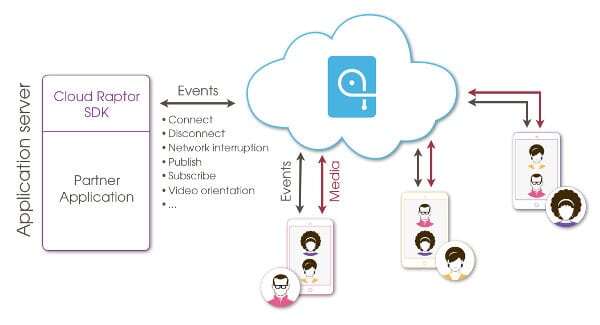Delivering a video communication platform to any developer.
This one is a doozy. There have been several acquisitions in the area of WebRTC. The most important one is the acquisition of TokBox by Telefonica Digital, which for me is a vote of confidence from a telco that this technology matters.

During WebRTC Conference & Expo, I caught up with Ian Small, CEO of TokBox, and asked him for an interview. I was more than happy when he obliged. Here are my questions and his answers.
What is TokBox all about?
TokBox operates a global WebRTC video platform and provides the tools for developers and enterprises to quickly and easily build live video communications into online and mobile commercial applications. Customers use our platform to power pre- and post-sales customer service, sports and entertainment experiences, brand advertising, and education services. TokBox’s OpenTok Platform provides everything you need to deploy scalable, bandwidth efficient WebRTC video communications for your business.
You are part of Telefónica now. Has that changed anything for you guys (besides the financial backing)?
Telefónica has been establishing a good track record of acquiring innovative technology companies while giving them the freedom and room they need to flourish. At a technical level, we’ve been able to take advantage of some of Telefónica’s in-depth understanding of networks, real-time QOS and mobile connectivity. But more importantly, having access to Telefónica’s global infrastructure and scale has further reinforced our ability to provide enterprise-grade service and has accelerated our ability to innovate around the WebRTC standard. As more enterprises are embracing video communications as part of their business and service offering, particularly around WebRTC, this infrastructure, scale and speed is increasingly critical.
I am interested to know – what value does Telefónica see in WebRTC and a video API platform?
Telefónica Digital (the innovation arm of Telefónica) has a mission to put digital at the core of the company. WebRTC, and video generally, are becoming a major part of the digital communications world, so it makes sense for Telefónica Digital to have a major beachhead in the future of digital communications, and to want to incorporate OpenTok-based applications into broader areas of the business. Telefónica has really embraced our level of innovation and the Silicon Valley thinking we bring to the business.
You started off as a Flash based API company. What made you switch your focus to WebRTC?
From the very beginning, we designed OpenTok to be protocol-neutral, because we believed that a then-undefined browser standard would eventually supersede Flash. Now that WebRTC is here, it has a wide range of advantages over Flash, starting with increased audio and video quality. For more than a year, we have focused almost all of our energy on the new standard – a focus that is now being rewarded with the expanding distribution and access to WebRTC. With WebRTC now natively part of Chrome and Firefox, and our bridging capability for other browsers as well as mobile devices, it is now a globally viable solution.
Where do you see Flash within your solution?
OpenTok supports both WebRTC and Flash implementations in a way that is transparent to the developer. Until Mozilla’s introduction of WebRTC support in Firefox just as WebRTC Expo got under way, Flash was more ubiquitous than WebRTC, but that is now changing quickly in the broad consumer marketplace. While we expect to support both platforms for the foreseeable future, our energies are focused on WebRTC with a clear expectation that it will supersede Flash completely.
What do you use for signaling?
We use a proprietary state-of-the-art messaging fabric called Rumor for signaling. Rumor was designed based on our experience with the wide variety of customer use cases we have seen across our Flash and WebRTC platforms over the last 3 years. Our experience was that trying to adapt existing protocols (XMPP, SIP, etc.) to the task didn’t deliver the flexibility and performance our customers needed; other platform companies in adjacent spaces have found this to be true as well. Rumor supports a variety of endpoints and is fully HTML5 compliant, so any modern browser with web socket support can take advantage of Rumor through our OpenTok platform. Why did we call our signaling infrastructure “Rumor”? Because, of course, nothing travels faster than a rumor…
The Cloud Raptor SDK, which we just introduced at WebRTC Expo, integrates a server application directly into the OpenTok cloud by connecting directly to the Rumor messaging fabric.

Can you tell me a bit about the technologies you selected for your back end?
To make OpenTok an enterprise-grade, WebRTC-native service – at the browser level, and in the cloud – most of what we need to do is pretty bleeding-edge. The core of our cloud is based on three scalable WebRTC-native components: Mantis, Rumor and Symphony. We brought Mantis out into the open a couple of months ago. Mantis is our cloud-based WebRTC media scaler, which routes, scales and shapes WebRTC traffic, and was custom-developed in-house.
In addition to Rumor (discussed more above), we also have a custom-built WebRTC session coordination server called Symphony which coordinates our distributed WebRTC cloud. We haven’t talked about Symphony before, so I guess your Q&A is its coming-out party! Internally, we use WebRTC compliant protocols such as RTP/RTCP for media and control. We distribute Mantis, Rumor and Symphony services in data centers around the globe, and operate it as one cloud.
You started off as a pure video API company, and now it seems that with your new offerings you are trying to provide a more complete solution. Any reason for that shift?
We are focused on providing all the pieces that a developer requires to build and manage the video communications component of a commercial application. We’ve had API’s, widgets, plug-ins, SDKs. Whatever makes life faster and simpler for a developer is what we’ll provide.
When you added WebRTC into your existing platform – what challenges did you face?
On the web side, we wanted our clients to be fully HTML5 compliant. This entailed adapting our signaling infrastructure to run over web-sockets so it could be as fast and highly performing as possible. In addition, we also wanted to interoperate with endpoints that had no native WebRTC support such as iOS devices, so that required building custom SDK libraries for those devices. Last, the WebRTC standard doesn’t include the end-to-end functionality needed to deliver real-world use cases. We built out a powerful cloud WebRTC infrastructure that provides value added services such as multi-party, intelligent adaptation to varying network conditions and enables scale.
Given the opportunity, what would you change in WebRTC?
WebRTC is a really great step forward for the browser world. But there are still some shortcomings in the standard, some of which will likely get resolved as real-world experience with WebRTC grows, and some of which reflect agendas of the key drivers of the standard. Top of mind real-world issues include things like temporal scalability support for video and discontinuous transmission of audio. And of course, the codec wars have very real implications for power-efficiency in mobile devices as well as narrowing the range of low-end devices that can use standards-compliant WebRTC – optional H.264 support would make a big difference to mobile penetration and usage.
What’s next for TokBox?
As much as we’ve gotten done to date, we feel like there’s a huge amount of road still ahead of us – and of the industry. We will continue to augment our underlying WebRTC capability with the enterprise infrastructure and tools that enable our customers and partners to deliver compelling, real-time video experiences online and in their mobile applications. There are more advances to be made in traffic scaling and shaping for improved audio and video quality, and we will deliver more use-case specific solutions like OpenTok for Customer Service, the pre-configured set of tools and components that makes it faster and easier to implement video for customer service applications. We’re looking forward to continuing to set the pace for native WebRTC cloud infrastructure, and to seeing face-to-face video become an everyday part of your application experience
–
The interviews are intended to give different viewpoints than my own – you can read more WebRTC interviews.
